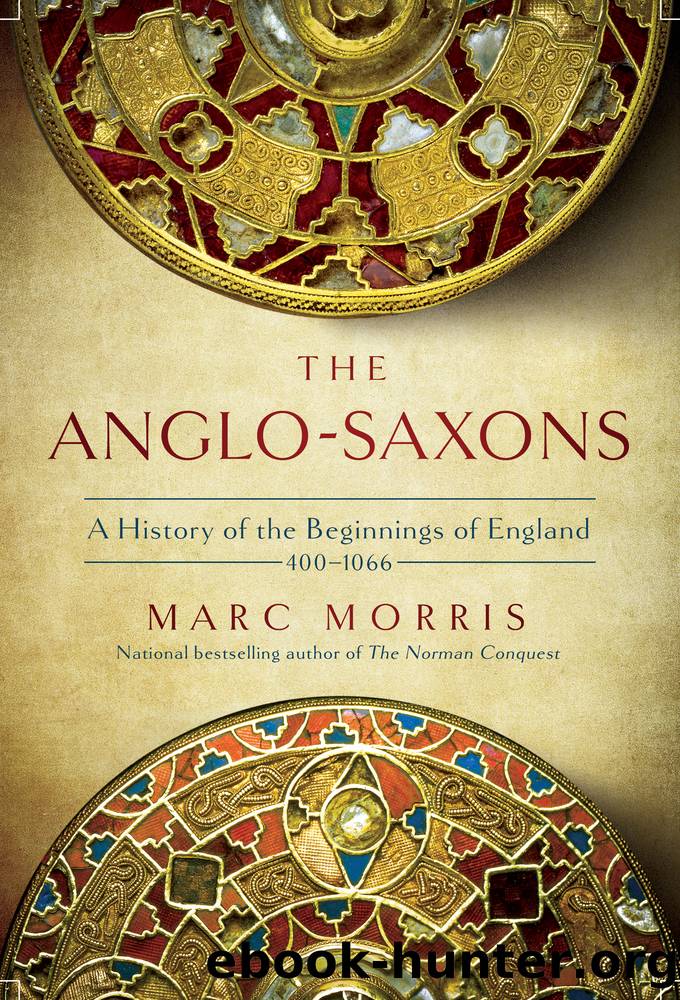The Anglo-Saxons by Marc Morris

Author:Marc Morris
Language: eng
Format: epub, mobi
Publisher: Pegasus Books
Published: 2021-05-25T00:00:00+00:00
* * *
The territorial status quo between the English and the Danes at the end of Alfredâs reign was much the same as it had been twenty years earlier. For all the later praise he attracted as the âfounder of Englandâ, the extent to which Alfred had expanded his kingdom had been relatively modest. He had maintained his rule in Wessex, and annexed the part of Mercia that lay to the west of Watling Street â the boundary agreed between the king and his erstwhile enemy, Guthrum, after the viking leaderâs submission in 878. Everything to the north and east of that line was ruled by men of Scandinavian descent.
The question of how many Scandinavians had settled in these areas cannot be answered decisively, but all the reliable evidence indicates that the number was substantial. As with the debate on Anglo-Saxon immigration to Britain in the fifth and sixth centuries, attempts to come up with an answer using DNA science produces inadequate data and highly debatable results. The linguistic and archaeological evidence, however, is both clear and compelling. Across large areas of northern and eastern England, we find many place names that end with either -by or -thorpe, both of which are elements imported from Old Norse. It was at this point, for example, that the monastery founded by St Hild at Streaneshalch became known as Whitby, and the settlement that had been Northworthig was renamed Derby. Almost half the place names in Yorkshire recorded in the Domesday Survey of 1086 had such Scandinavian origins. In addition, thousands of Norse loan-words appear in English sources written after the late ninth century. One notable grammatically borrowing was the words they, their, and them.11
The linguistic argument, which has stood for some time, has lately been boosted by the discovery of archaeological finds from the late ninth and early tenth centuries that are unmistakably Scandinavian: coins, clothes fittings, and amulets with pagan symbols. In recent decades metal-detectorists have uncovered around 500 such items in northern and eastern England, often in isolated rural areas. Most are non-elite objects and, in the case of the clothes fittings, made for both male and female owners, suggesting that Scandinavians of all ranks had settled in these areas, just as the testimony of the Anglo-Saxon Chronicle would lead us to suppose. Historians who have analysed all this evidence have cautiously suggested that the total number of newcomers might have been somewhere between 20,000 and 35,000.12
Modern historians often refer to the area of Scandinavian settlement as âthe Danelawâ, although that term does not occur in our sources until the early eleventh century, and can give the misleading impression that these lands somehow constituted a single entity. The reality was that the area of Danish settlement was split into several distinct political zones, and governed by a galaxy of competing rulers â kings whose names are mostly unrecorded, and also jarls and holds, who were equivalent in status to ealdormen and kingâs thegns. The ancient English kingdom of East Anglia,
Download
This site does not store any files on its server. We only index and link to content provided by other sites. Please contact the content providers to delete copyright contents if any and email us, we'll remove relevant links or contents immediately.
| Africa | Americas |
| Arctic & Antarctica | Asia |
| Australia & Oceania | Europe |
| Middle East | Russia |
| United States | World |
| Ancient Civilizations | Military |
| Historical Study & Educational Resources |
Magic and Divination in Early Islam by Emilie Savage-Smith;(1516)
Bohemians, Bootleggers, Flappers, and Swells: The Best of Early Vanity Fair by Bohemians Bootleggers Flappers & Swells- The Best of Early Vanity Fair (epub)(1368)
Ambition and Desire: The Dangerous Life of Josephine Bonaparte by Kate Williams(1366)
Papillon by Henry Charrière(1356)
Twelve Caesars by Mary Beard(1296)
Operation Vengeance: The Astonishing Aerial Ambush That Changed World War II by Dan Hampton(1148)
What Really Happened: The Death of Hitler by Robert J. Hutchinson(1142)
London in the Twentieth Century by Jerry White(1124)
Time of the Magicians by Wolfram Eilenberger(1108)
The Japanese by Christopher Harding(1107)
Twilight of the Gods by Ian W. Toll(1104)
Lenin: A Biography by Robert Service(1062)
The Devil You Know by Charles M. Blow(1005)
A Social History of the Media by Peter Burke & Peter Burke(961)
Freemasons for Dummies by Hodapp Christopher;(945)
Napolean Hill Collection by Napoleon Hill(918)
Henry III by David Carpenter;(905)
The Churchill Complex by Ian Buruma(893)
The Rise and Triumph of the Modern Self by Unknown(893)
